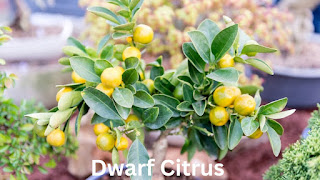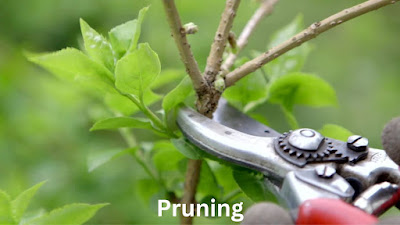Here is a general overview of the cultivation process for the 10 best fruit trees for a small garden:
Dwarf Apple Trees:
Planting: Choose a sunny location with well-draining soil. Dig a hole, plant at the same depth as in the container, and water thoroughly. Plant your trees 1.2–1.5 meters apart after running high-tensile wire between the garden stakes. Cut off the remaining branches on each tree, saving the two that will naturally develop into a T-shape at the top. The two branches should be gently bent to follow the wire, then tied off using gentle tree ties.
Watering: Keep the soil consistently moist, especially during dry periods. After planting, give the plants regular watering for at least six weeks. Water the trees frequently in the spring and summer as the fruit develops when they reach maturity.
Pruning: Prune in late winter to maintain shape and encourage fruiting. Remove dead or crowded branches. Reduce the length of each arm by a third in the winter to promote more fruiting spurs. You can also reduce new shoots that emerge on the stem by pruning them back until only one bud is left. You can use the Cyclone Heavy Duty Bypass Pruner, available at Bunnings, to prune your tree without causing any damage.
<script async src="https://pagead2.googlesyndication.com/pagead/js/adsbygoogle.js?client=ca-pub-2985789920568613"
crossorigin="anonymous"></script>
Dwarf Pear Trees:
Planting: Standard-sized trees should be spaced 20 to 25 feet apart, while dwarf pears should be spaced 12 to 15 feet apart. Create a hole that is slightly larger and deeper than the plant roots spread. Don't bend the roots too much as you stretch them out from the trunk, and don't fill the hole with earth or fertilizer.
Watering: Water your tiny fruit plants on a regular basis. The soil needs to be damp but not drenched. The leaves are more prone to sunburn if the soil is very dry. Furthermore, envelop every tree's base with a sparse covering of mulch to preserve moisture and shield the roots from severe weather.
<script async custom-element="amp-auto-ads"
src="https://cdn.ampproject.org/v0/amp-auto-ads-0.1.js">
</script>
Pruning: How to trim little pear and apple trees. When dwarf apple and pear trees are dormant, from November to early March, they should be trimmed: Start by trimming off any weak, dead, or diseased growth, as well as any crossing branches. Aim to build a simple, transparent framework.
Dwarf Plum Trees:
Planting: Consideration must be given to the location, preparation of the soil, and planting methods while planting miniature plum trees in your yard. Create a hole that is exactly as deep and twice as big as the dwarf plum tree's root ball. At the bottom of the hole, loosen the earth. Pretty common dwarf plum varieties are 'Pixie,' 'Santa Rosa,' and 'Methley.'
Watering: Choose a dwarf plum tree cultivar that is appropriate for your soil type and climate. Avoid overwatering.
Pruning: Pruning dwarf plum trees is important to promote a strong structure, enhance air circulation, and encourage fruit production. Conduct most of the pruning during the dormant season, typically in late winter or early spring.
Cherry Trees:
Planting: To ensure healthy growth and abundant harvests, planting cherry trees requires careful site selection, soil preparation, and planting practices. Sweet cherries and sour cherries are common variations. Adjusting the depth of the hole is necessary.
Watering: As soon as the tree is planted, give it plenty of water. Water the soil frequently, especially in dry spells, to maintain a constant moisture level, particularly in arid periods.
Pruning: Prune in late winter for shaping and to remove any diseased or dead branches.
<script async src="https://pagead2.googlesyndication.com/pagead/js/adsbygoogle.js?client=ca-pub-2985789920568613"
crossorigin="anonymous"></script>
Columnar Apple Trees:
Planting: Planting columnar apple trees, which have a narrow, upright growth habit, is a great choice for small gardens or container gardening. Choose a sunny location with well-draining soil. Ensure the site receives at least 6 hours of direct sunlight daily. Good air circulation is important for preventing diseases. Soil is slightly acidic to neutral pH (around 6.0-7.0). Amend the soil with organic matter like compost if needed.
Watering: Proper watering is crucial for the health and productivity of columnar apple trees. Immediately after planting, give the columnar apple tree a thorough watering to settle the soil around the roots. In general, plan to water columnar apple trees every 7-10 days.
Pruning: Minimal pruning is required. Remove dead or damaged branches as needed.
<script async src="https://pagead2.googlesyndication.com/pagead/js/adsbygoogle.js?client=ca-pub-2985789920568613"
crossorigin="anonymous"></script>
Fig Trees:
Planting: Select a fig tree variety that is well-suited to your climate. Common varieties include 'Brown Turkey,' 'Celeste,' and 'Chicago Hardy' for cold climates. Figs thrive in full sun. Choose a location with at least 8 hours of direct sunlight per day.
Watering: Water the fig tree regularly during its first year to help establish a strong root system. Provide deep, thorough watering. Allow the water to penetrate the soil to a depth of at least 6-8 inches during each watering session.
Pruning: Prune fig trees during late winter or early spring while the tree is still dormant. Remove any dead or diseased branches. Thin out crowded or weak branches to improve air circulation and sunlight penetration.
<script async src="https://pagead2.googlesyndication.com/pagead/js/adsbygoogle.js?client=ca-pub-2985789920568613"
crossorigin="anonymous"></script>
Patio Peach Trees:
Planting: Select a patio peach tree variety that is well-suited to your climate and the available space. Patio peach varieties, such as 'Bonanza' or 'Pixzee,' are designed for compact spaces. Choose a location with at least 6-8 hours of direct sunlight per day. Carefully remove the patio peach tree from its container, being gentle with the roots.
Watering: Water the patio peach tree regularly during its first year to help establish a strong root system. Provide deep, thorough watering & a depth of at least 6-8 inches during each watering session. Ensure proper drainage to prevent waterlogging.
Pruning: Prune patio peach trees during late winter or early spring while the tree is still dormant. Remove any dead, damaged, or crossing branches. Encourage an open center shape by removing the central leader and encouraging outward growth
<script async src="https://pagead2.googlesyndication.com/pagead/js/adsbygoogle.js?client=ca-pub-2985789920568613"
crossorigin="anonymous"></script>.
Dwarf Citrus Trees:
Planting: Select a dwarf citrus tree variety that suits your climate. Common types include dwarf lemon, lime, and orange varieties. Container-grown citrus trees need citrus potting mix. Choose a location with at least 6-8 hours of direct sunlight per day. Soil with a slightly acidic to neutral pH (around 6.0-7.0).
Watering: Ensure that the soil is continuously moist, particularly in arid periods. Allow the water to penetrate the soil to a depth of at least 6-8 inches during each watering session.
Pruning: Prune as needed to shape the tree and remove dead or crowded branches. Prune dwarf citrus trees to shape them when young. Prune to control the size of the tree if needed. This is especially important for container-grown dwarf citrus.
Dwarf Kiwi:
Planting: Plant in well-draining soil with support for climbing vines. Water thoroughly after planting. Select a dwarf kiwi variety suitable for your climate and available space. Common varieties include 'Issai' and 'Arctic Beauty.'
Watering: Keep the soil consistently moist, especially during dry periods. Dwarf kiwi trees may require more frequent watering during hot and dry periods.
Pruning: Prune in late winter to control size and shape. Remove any suckers (shoots emerging from the base of the tree) to maintain a clean and well-shaped tree.
Columnar Apricot Trees:
Planting: Plant in well-draining soil, providing support if necessary. Select a columnar apricot tree variety that suits your climate. Some examples include 'Tasty Treat' and 'Aprigold.'
Watering: Water regularly to maintain consistent moisture. Water the columnar apricot tree regularly during its first year to help establish a strong root system. Provide deep, thorough watering. Columnar apricot trees prefer well-draining soil.
<script async src="https://pagead2.googlesyndication.com/pagead/js/adsbygoogle.js?client=ca-pub-2985789920568613"
crossorigin="anonymous"></script>
Pruning: Minimal pruning is required. As needed, cut off any damaged or dead branches. Prune columnar apricot trees to shape them when young. Remove the sucker for a well-shaped plant.
Throughout the cultivation process, monitor for pests and diseases, and apply appropriate treatments. Fertilize according to the specific needs of each fruit tree, and adjust care practices based on local climate and soil conditions. Regular attention to watering, pruning, and overall tree health will contribute to successful fruit production in a small garden.












.jpg)





.jpg)